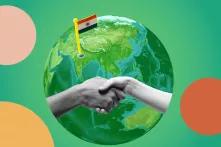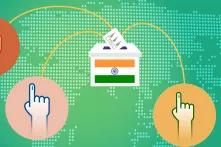How India navigates the many competing forces and interests at play in the social media landscape will be critical in determining the future and health of its democracy.

With rising internet penetration in India coupled with the availability of affordable data plans and smartphones[1][2], social media has been a site of political mobilisation. India’s next general election is scheduled in seven phases from April 19, 2024 to June 1, 2024. The 2019 general election was the first national election in which approximately one-third of the voting population had access to social media[3]. While the direct electoral impact of social media campaigns is hard to completely determine[4], social media has intrinsically transformed the way voters and political parties connect and engage in the electoral process. This rise of online influence presents both opportunities and challenges during elections.
Mis/disinformation and fact checking
Election-related misinformation and disinformation are known to proliferate and work via various modes.
A research paper on misinformation on social media during the 2019 election season showed that the spread of false information was a part of the campaigns by major parties against their opponents[5]. The majority of the misinformation originated from the accounts of the Bharatiya Janata Party (BJP) and the Indian National Congress (INC). The paper identified “electoral campaign, corruption, religion, celebrity, nationalism, and gender and development” as dominant topics of misinformation.
Political parties reportedly circulated deepfake media on WhatsApp and social media pages during the elections that were held in 2023 in the country[6]. One such video was that of a leader of a political party in Telangana urging the people to vote for his rival party[7].
A recent investigation by Access Now and Global Witness shows that YouTube approved 48 advertisements in English, Hindi, and Telugu that violated YouTube’s policies about advertising and elections misinformation[8].
The infrastructure that is accessible to political entities, the nature of the medium, and the large user base in India ensure the quick proliferation of content that is manipulated and intended to mislead readers or viewers. Misinformation/ disinformation adversely impact election integrity, undermine the electoral process, and jeopardise democracy. It may deceive voters, warp their awareness and understanding of key electoral issues, create echo chambers, and replace verified and reliable information.
Independent fact checking platforms in India include AltNews[9] and Boom[10]. The Indian government’s Press Information Bureau (PIB) runs PIB Fact Check[11]. The Supreme Court recently ordered a stay on the establishment of a Fact Check Unit of the PIB as a body with the power to mark alleged misinformation published in connection with the government and its agencies[12].
The role of influencers
Political parties increasingly engage influencers on YouTube and Instagram to post content that is hyperlocal and micro-targeted (directed at demographics and interests)[13]. It is intended to reach rural voters, “swing voting patterns, manage crises, and help them secure power”, among other things[14]. Influencers publish both direct and subliminal messages, which are undifferentiated from their opinions. The messaging aims to humanise the political figures, who are the subject of the message, and create a persona of them, fostering a sense of closeness and active involvement among voters. The practice of engaging influencers is a departure from previous reliance on celebrities such as actors and sportspersons. However, there is no transparency about whether or not influencers receive compensation and from whom. If they do, then the promotional nature of the content is often not disclosed to their viewers[15]. Undisclosed paid content is yet another mode via which propaganda may affect electoral integrity. Such content also circumvents regulations about political advertising set by the Election Commission of India (ECI), the body that conducts and regulates elections in the country.
Besides influencers, loosely-networked actors on social media disseminate and amplify speech. They have no institutional or organisational affiliations, are composed of influencers and the general public, and may thus play a role in influencing the choices of voters[16].
Electoral campaigns
Most Political parties have their social media channels, with employees dedicated to run them. However, wealthy parties have “IT Cells”, which feed content into social media round the clock[17]. IT Cells monitor social media trends and create strategies for the dissemination of their content[18]. The 2019 general election was dubbed the “social media election” due to the unprecedented use of social media by politicians and political parties in an attempt to directly reach the public, bypassing the mainstream press. The campaigns of the incumbent BJP have followed a pattern in which supporters and politicians alike attach a persona to their online accounts, indicating a direct and personal connection with Prime Minister Narendra Modi. The persona was that of a Chaiwala (meaning “tea-seller”) in the 2014 election season, a Chowkidar (#MainBhiChowkidar; meaning “I am a watchman too”) in 2019, and “Modi ka parivar” (meaning “I am a member of Modi’s family”) in 2024. This pattern is consistent with the PM’s direct, one-way messaging with the public on social media and radio programmes such as Mann Ki Baat.
Pal et al analysed a database of 6.9 million tweets, collated from the accounts of 17,261 politicians across 127 parties in India to find patterns related to the 2019 elections[19]. They found that every major political party was well-invested in Twitter, which was later renamed X. However, The BJP had the most effective use of a party central account, and for the most part the BJP dominated electoral campaigning on the platform. Another noteworthy finding was that the handles of political figures and parties communicated in English and a range of Indian languages, indicating the widening of politicians’ reach beyond the English-speaking populace and the use of social media for localised, grassroots mobilisation.
Regulatory mechanisms
Ahead of the 2019 election, major social media companies – Google, Facebook, WhatsApp, Twitter, ShareChat, and TikTok – among others, agreed to a “voluntary code of ethics” submitted to the ECI[20]. The companies committed to conduct education and communication campaigns to bring awareness about elections, create a high-priority dedicated grievance redressal channel to address objectionable posts, quickly act upon reported violations of the Model Code of Conduct (MCC), and advance certification of all political advertisements published on their platforms. However, this self-regulatory mechanism is inadequate for countering problems of extreme speech, algorithmic bias, and proxy campaigns.
Another initiative started before the 2019 elections was “Ads Transparency” by Facebook and Google to shed light on political advertisements. The BJP dominated digital political spending on both platforms, with a 41.4% share on Google and 14.7% on Facebook[21]. The expenditure reported by other political parties was substantially lower. Significant expenditure on political advertising on digital platforms is done by entities that have direct or indirect linkages to the political parties, making the exact quantum of spending difficult to track. It also falls outside the scope of activities pre-certified as political advertising by parties.
The MCC, which comes into effect once the ECI announces the election dates, contains guidelines that require political parties and candidates to disclose their expenditures made on social media advertisements. The ECI, at the time of writing, does not have any guidelines or rules specifically about deepfakes. However, It has a district-wise list of 300 influencers whose accounts it has been monitoring[22]. The ECI set up a Social Media Cell to disseminate information, guide and train local administrations, “maximise the use of social media, making it more interactive and interesting for the general public”, monitor real-time social media activity, news, and advertisements, flag sensitive content, and handle complaints of violative content[23][24].
Concerns over censorship
In the run-up to the 2019 elections, X was the target of the government's ire over a range of issues, including an alleged “leftist” bias and a “manipulated media” tag posted over a tweet made by one of the leaders of the ruling party[25]. It received summons on a few occasions from Parliamentary committees demanding that it state what it was doing to “prevent misuse” of its platform, to correct its “leftist bias”, and so on[26]. Facebook, which was later renamed Meta, also received such summons once, in 2021[27].
India has long held the position of the country with the highest number of state-initiated internet shutdowns, which range from blanket blackouts of all telecommunications to blocking of specific modes such as mobile internet. Maintaining law and order, quelling violence or public unrest, and curbing the spread of misinformation are among the common reasons the government cites for implementing shutdowns. More than 30 internet shutdowns were recorded ahead of the 2019 elections[28]. In February and March 2024, a prolonged internet shutdown that was implemented following farmers’ protests, and the blocking of 177 social media accounts linked to the protests or supporting them, sparked fears of more digital crackdowns ahead of the polls[29][30]. Intentional internet shutdowns and content blocking continue to be major concerns for the upcoming Lok Sabha elections.
What the text is now: digital crackdowns. Thus intentional internet shutdowns and content blocking continue to be major concerns for the upcoming general elections that will take place between 19 April and 01 June 2024.
Marginalised voices
On the more positive side, Social media enables the voices of people from marginalised backgrounds to conduct election-related mobilisation and shine a light on electoral issues that are usually neglected by the mainstream press. Similarly, it expands the reach of issues chosen by alternative and independent media. The Mooknayak, for example, which highlights the stories of Dalits and Adivasis, is focussing on the issues of marginalised women and parliamentary seats reserved for candidates from marginalised communities[31].
Conclusion
The US-based non-profit organisation Freedom House recently released the Election Vulnerability Index, consisting of key election-related indicators regarding a country’s political rights and internet freedom[32]. India is ranked 62/100 with 100 representing the least vulnerability[33]. Social media offers opportunities for increasing political participation and empowering voters. It is crucial to encourage media literacy and critical engagement with social media content to tackle the spread of misinformation in the endeavour to maintain free and fair elections for the country's democratic future.
Endnotes
[1] More than half of India’s population uses the Internet (760 million users) https://www.aljazeera.com/news/2024/2/20/deepfake-democracy-behind-the-ai-trickery-shaping-indias-2024-elections
[2] By May 2019, roughly one-third of Indians had access to Facebook (up from 9% in 2014), Whatsapp and YouTube (CSDS lokniti 2019). There were 911 million broadband connections in India as of January 2024, according to a report of the telecom regulator, the TRAI. https://www.medianama.com/2024/04/223-indias-broadband-user-base-hit-911-million-mark-january/
[6] https://www.thehindu.com/society/2024-india-general-election-how-far-will-artificial-intelligence-go-deepfakes-political-parties-chatbots-misinformation-fake-news/article67990487.ece
[7] https://www.aljazeera.com/news/2024/2/20/deepfake-democracy-behind-the-ai-trickery-shaping-indias-2024-elections
[8] https://www.globalwitness.org/en/campaigns/digital-threats/votes-will-not-be-counted-indian-election-disinformation-ads-and-youtube/
[12] https://www.aljazeera.com/news/2024/3/21/india-top-court-stays-government-move-to-form-fact-check-unit-under-it-laws
[13] https://www.context.news/digital-rights/social-media-influencers-are-indias-new-election-campaigners
[15] Ibid.
[18] https://www.hindustantimes.com/india-news/bjp-plans-a-whatsapp-campaign-for-2019-lok-sabha-election/story-lHQBYbxwXHaChc7Akk6hcI.html
[22] https://www.thehindu.com/news/national/karnataka/social-media-influencers-on-ec-radar-but-telling-opinion-apart-from-paid-content-is-a-challenge/article67972709.ece
[25] https://www.buzzfeednews.com/article/pranavdixit/twitter-political-bias-denial, https://www.outlookindia.com/website/story/india-news-manipulated-media-controversy-government-vs-twitter/383352
[27] https://timesofindia.indiatimes.com/india/parliamentary-panel-on-it-summons-facebook-and-twitter-officials-on-jan-21/articleshow/80316425.cms
[29] https://www.livemint.com/news/india/farmers-protest-centre-blocks-177-social-media-accounts-to-maintain-public-order-x-facebook-snap-reddit-instagram-11708394874341.html
[30] https://www.context.news/digital-rights/indian-farmers-cut-off-as-activists-warn-of-pre-election-blackouts
[33] https://freedomhouse.org/report/election-watch-digital-age#india-2024
Disclaimer:
This article was prepared with the support of the Heinrich Böll Stiftung. The views and analysis contained in the publication are those of the author and do not necessarily represent the views of the foundation. Heinrich Böll Stiftung will be excluded from any liability claims against copyright breaches, graphics, photographs/images, sound document and texts used in this publication. The author is solely responsible for the correctness, completeness and for the quality of information provided.


